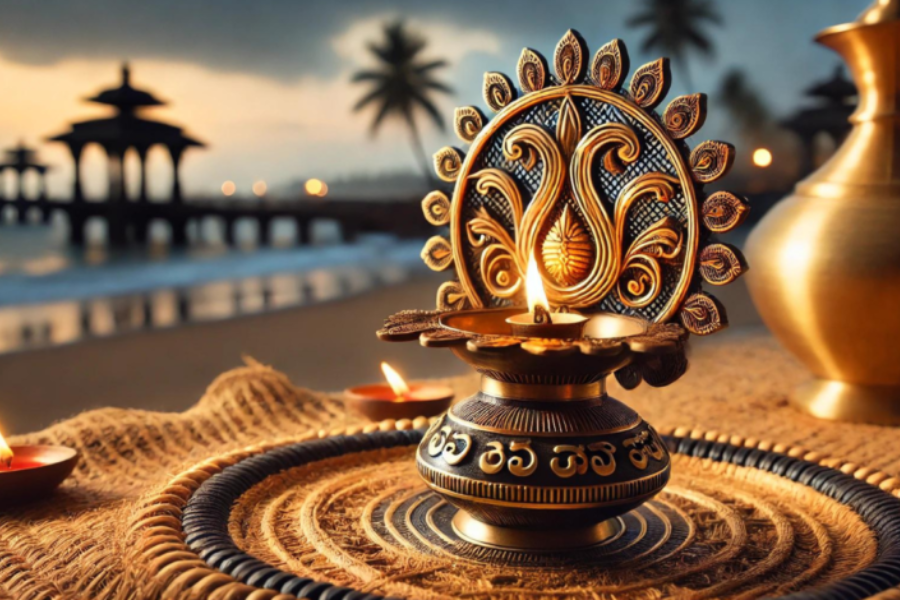Vavilaku in Tulu: Illuminating the Cultural Heritage of a Vibrant Community
To appreciate the significance of the Vavilaku, it’s important to first understand the Tulu community. Tulu Nadu, the region where Tulu speakers reside, includes the districts of Dakshina Kannada and Udupi in Karnataka, India. The Tulu language, a member of the Dravidian family, is spoken by approximately 1.8 million people. The culture of the Tulu community is a rich tapestry woven from folklore, traditional music and dance, and unique rituals passed down through generations.
The Origin and Evolution of Vavilaku in Tulu Culture
Historical Roots
The Vavilaku, a traditional oil lamp, has been an integral part of Tulu culture for centuries. Its roots trace back to ancient agricultural societies in the region, where it symbolized divine presence, prosperity, and protection for the community. As time progressed, so did the design and function of the Vavilaku. Initially crafted from simple earthenware, these lamps have evolved into intricate designs made from brass and bronze, often cherished as family heirlooms.
Cultural Significance
In Tulu culture, the Vavilaku transcends mere utility; it embodies deep spiritual meaning. Symbolizing the victory of light over darkness and knowledge over ignorance, the lamp plays a central role in various rituals and ceremonies, acting as a bridge between the physical and spiritual realms. It is believed that the flame of the Vavilaku wards off evil spirits and brings good fortune to those who keep it lit.
The Role of Vavilaku in Tulu Festivals and Rituals
Kambala and Vavilaku
Kambala, a traditional buffalo race held in waterlogged paddy fields, is one of the most celebrated festivals in Tulu culture. The lighting of the Vavilaku marks the commencement of the festivities, with prayers offered for a successful event. The lamp symbolizes the invocation of divine blessings, ensuring that the celebrations proceed without obstacles.
Bhoota Kola and Vavilaku
Another significant Tulu ritual is Bhoota Kola, which honors local spirits or deities known as Bhootas. Here, the Vavilaku takes center stage, lit to signify the presence of these divine entities. The light from the lamp is thought to guide spirits during the ritual, fostering protection and goodwill for the community. The Bhoota Kola is a vibrant and dramatic performance, and the Vavilaku enhances the spiritual depth of the event.
Daily Rituals and the Vavilaku
Everyday Significance
In many Tulu households, lighting the Vavilaku at dusk is a cherished daily ritual. This practice is believed to attract prosperity and repel negative energies. Typically placed in the prayer room or at the entrance of the home, the lamp symbolizes the welcoming of positive energies and divine presence. This daily lighting underscores the community’s belief in the protective and prosperous power of light.
Special Occasions
During special events such as weddings, housewarming ceremonies, and religious observances, the Vavilaku’s role becomes even more significant. It is utilized in various rituals to bless the occasion and ensure the participants’ well-being. The presence of the Vavilaku is considered auspicious, and its light is thought to bring good fortune and success to the event.
The Contemporary Relevance of Vavilaku in Tulu Culture
Preservation of Tradition
Despite rapid modernization and lifestyle changes, the Vavilaku remains culturally significant. It symbolizes the community’s rich heritage and enduring connection to traditional values. In modern Tulu households, the Vavilaku is a beloved artifact, especially during festivals like Deepavali, where the lighting of oil lamps is a cherished custom.
Modern Celebrations and the Vavilaku
In contemporary celebrations, the use of the Vavilaku illustrates the blend of traditional practices with modern life. The lamp is lit in homes and public spaces during important festivals, upholding the tradition of celebrating light and dispelling darkness. Cultural organizations and community groups often conduct workshops and events to educate younger generations about the Vavilaku’s significance, ensuring that this cherished tradition is preserved.
The Symbolism of Vavilaku in Tulu Spirituality
Light as a Spiritual Symbol
In Tulu culture, the Vavilaku serves as a powerful spiritual symbol. The flame represents the illumination of knowledge that dispels the shadows of ignorance. Lighting the lamp is often accompanied by prayers and offerings, reinforcing the belief that divine presence is invoked through this act. The Vavilaku reminds the community of the spiritual values central to Tulu culture, emphasizing knowledge, purity, and divinity.
Connection to Nature and Deities
Tulu spirituality deeply intertwines with nature and the worship of local deities. The Vavilaku, with its illuminating light, acts as a medium for expressing this connection. Whether during rituals dedicated to Bhootas or at agricultural festivals like Kambala, the lamp remains a constant presence, symbolizing the community’s reverence for nature and its deities.
Conclusion
The Vavilaku in Tulu culture is more than a traditional oil lamp; it is a symbol of the rich cultural and spiritual heritage of the Tulu-speaking community. From its historical roots to its role in contemporary celebrations, the Vavilaku continues to illuminate the lives and traditions of this vibrant community.
By understanding and appreciating the significance of the Vavilaku, we connect with the deeper cultural values and practices that have been cherished for generations. Through its preservation and promotion, the Tulu community ensures that its cultural heritage remains alive, even amidst modern challenges. The lamp’s light not only dispels physical darkness but also serves as a beacon of the community’s enduring faith, values, and identity. As we explore and celebrate the traditions of the Tulu community, the Vavilaku will undoubtedly remain a central symbol of their vibrant cultural tapestry.
Explore captivating insights and stories about your favorite stars at craze radar.






